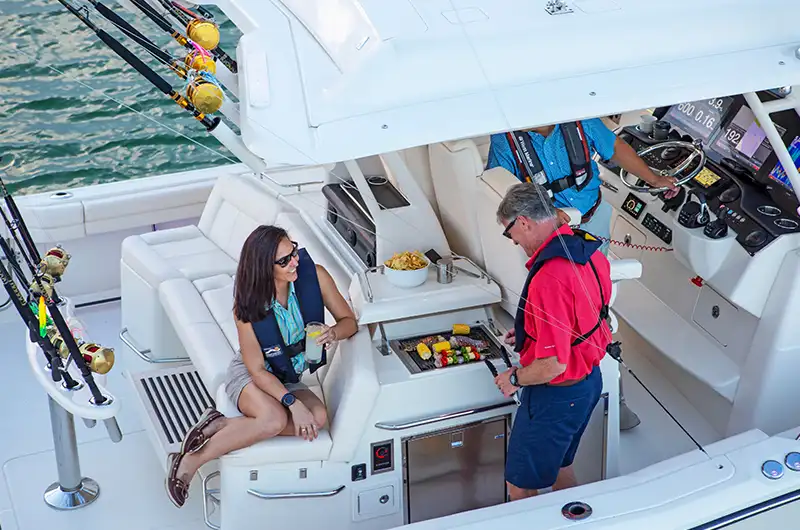
Photo courtesy of Grady White Boats, Inc.
With protective wraps now coming off winterized vessels in colder climates, and warmer locations already seeing boating season in full spring session, most boat owners are looking forward to hitting stride on their favorite waters. Still, there is time left for a few boat upgrades that might make your everyday experiences on the water just a little more comfortable, relaxing, enjoyable, fun and safe if you can tolerate a few last-minute additions. Here are a few ideas worthy of consideration.
Small Additions
Grab Some Dock Buddies
These are stretchable dock lines that allow you to quickly and easily tie-up to docks with no knots needed. Designed for temporary day use, each line is useful at gas docks, pump-out stations, or supply shacks. They also absorb shock from currents, tides, and traffic, reducing abrasion and jolts when your boat is secured. Simply slip one end loop over your boat cleat and the opposite end over the dock cleat. Slide the loop adjusters to tighten the loops and you’ll be secured. Depending on line size and how many come in a pack, expect to pay from $20 to just under $100.
Add Multicolor LED Lighting
Wish you had mood lighting that changed colors at your command? Mounted water-proof multi-colored marine LED rope lights under the gunwales, around seating areas and even your cockpit. Wire-in the power supply, flip a switch and light up not only your entire boat but its guests and crew as well. Depending on how much lighting you need, it may be necessary to purchase more than one set of lights. Prices vary based on rope lights length. Figure $25 to $90 as the going rate per set.
Install a High Water Alarm
A high water alarm sounds to let you know there is an excessive water level in your bilge, giving you precious time to correct the situation before it gets out of hand. Although the Coast Guard requires this device on boats measuring 26 feet and larger, it’s inexpensive and can save you big trouble and a lot of time. Installing a high water alarm is simple, especially considering you can purchase battery operated systems that mount with adhesive pads. If you’d rather go the hard-wired route, which requires tapping into the battery or bus bar, this is still a DIY task as long as you are comfortable running wire. You’ll find high water alarms starting at about $30 for battery-operated options and ranging up to about $200 for dual audio/visual warning systems.
Mid-Range Ideas
USB Charging Ports
Cell phones, iPads, tablets and laptops are of little use if they run out of juice. The on-board solution is to add a Marine-grade USB charging port or two. Look for a double-port receptacle that has a round cut-out so mounting will require nothing more than drilling a single hole and connecting to a positive and negative power feed from your vessel’s 12-volt battery system. Prices start under $20 but can climb higher depending on features and design. Costs rise with more ports, integration into a phone cradle or mount, and additional configurations or features.
See-Through Livewell Lids
Here’s an interesting tidbit: studies have demonstrated that baitfish being banged around in a dark livewell are more prone to die due to stress than baits in a livewell with a clear lid. Some anglers will also tell you that it’s a pain to keep lifting an opaque, colored or dark livewell lid just to see how much you have left, and how lively they appear. Whether you need to replace a damaged lid or want to upgrade to a clear one, the process is relatively painless. Usually, it simply entails removing the old lid and screwing or bolting on the new one. Expect to pay between $300 and $500 for standard replacements but more for custom designs.
Upgrade Your Fish-Finder
This is another task that sounds like a big job but doesn’t need to be. We’re not suggesting a fish-finder replacement, just bringing it up to date. Start by checking your manufacturer’s website for the software update procedure, which often requires no more than a WiFi link. Once you’ve downloaded all the updates, consider swapping out the transducer so you can fully take advantage of any new functions or features added. Most software updates are free for the asking. A new transducer typically runs between $200 and $500 but can run higher if it features top-shelf functions.
Go Big, Go Loud
Start by upgrading the receiver first. Begin by measuring the cutout if one exists. Finding a new model that fits this pre-cut hole saves the time and energy required to cut through fiberglass and immediately narrows down your choices to a few models rather than dozens. Look for a receiver that has Bluetooth and other connectivity, plus a built-in amplifier to help get the most out of your speakers.
Opting for a quality receiver before upgrading the rest of the audio system should get you off to a solid start because all that great sound, good vibrations and great times that ensue stem from making a quality choice at the start of the job. Once you’ve locked in on that receiver, you can put any remaining budget toward upgrading your amplifier, speakers and subwoofers.
Expect to pay from $100 to $800 for a quality marine-grade audio receiver, based on size, power output and options.
